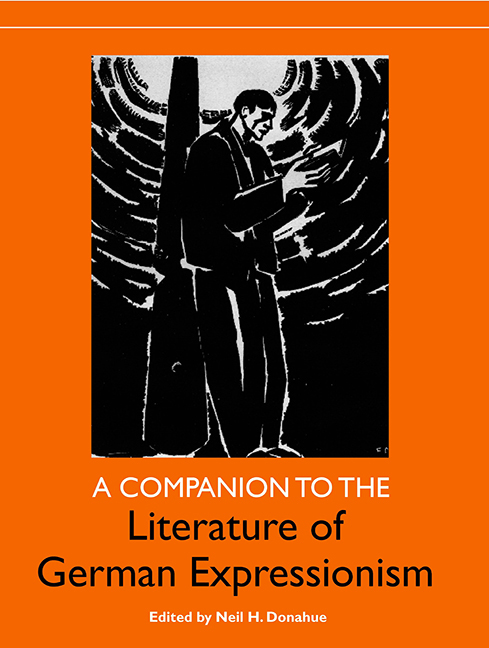Book contents
- Frontmatter
- Contents
- List of Illustrations
- Preface and Acknowledgments
- Chronology
- Introduction
- Philosophical Background
- Prose
- 2 The Prose of German Expressionism
- 3 Prosaic Intensities: The Short Prose of German Expressionism
- 4 The Cutting Edge of German Expressionism: The Woodcut Novel of Frans Masereel and Its Influences
- Poetry
- Drama
- Interdisciplinary
- Select Bibliography
- Notes on the Contributors
- Index
3 - Prosaic Intensities: The Short Prose of German Expressionism
from Prose
Published online by Cambridge University Press: 28 April 2017
- Frontmatter
- Contents
- List of Illustrations
- Preface and Acknowledgments
- Chronology
- Introduction
- Philosophical Background
- Prose
- 2 The Prose of German Expressionism
- 3 Prosaic Intensities: The Short Prose of German Expressionism
- 4 The Cutting Edge of German Expressionism: The Woodcut Novel of Frans Masereel and Its Influences
- Poetry
- Drama
- Interdisciplinary
- Select Bibliography
- Notes on the Contributors
- Index
Summary
The intensity of Expressionist prose, its linguistic dislocation and abstraction, rendered it thoroughly unsuited to the long form and measured pace of the novel. As Albert Soergel noted already in his monumental study Dichtung und Dichter der Zeit: Im Banne des Expressionismus (Poetry and Poets of the Age: In Thrall of Expressionism, 1925): Expressionism is “lyrischer Zwang, dramatischer Drang, nicht epischer Gang” (lyrical stress, dramatic duress, not epic progress; 796). The drama of Expressionism with its incantations and bombast also seems uncongenial to audiences in the twenty-first century. Yet the lyric poetry and short prose of Expressionism retains a capacity to shock, to unnerve, and to shatter habitual modes of perception: the Expressionist period abounds in short works of intense narrative experimentation, some successful, some less so, but which all put on display the energy and ambitions of the day to reform the genre. Such texts exhibit, despite the time that has now elapsed since their composition, remarkable virtuosity and freshness. Indeed, the formal and linguistic experimentation by the authors I shall discuss in this chapter makes their work not only challenging but also of enormous literary-historical significance.
As a literary movement Expressionism is conventionally dated between 1910 and 1925. It is characterized as sharing with other movements around the turn of the century, variously categorized as neo-Romanticism, Symbolism, Impressionism or Jugendstil, a rejection of scientific positivism and its artistic counterpart of Naturalism in literature and painting. Expressionism proper seeks to take that opposition to Naturalism to a new formal extreme, insisting that its aim is not a naturalistic depiction of the external world, nor even an impressionistic capturing of the shifting patterns of light on the surface of that reality, but an intuitive grasp of essence. Expressionist “vision” cuts through surface appearances to reveal that hidden essence. The theoretical underpinning of Expressionist writing suggests an eclectic appropriation of ideas current in art history and philosophy. One of the key influences is Wilhelm Worringer's Abstraktion und Einfühlung (Abstraction and Empathy, 1908). Worringer's thesis is that Greco-Roman art, together with Western art since the Renaissance, is an art of empathy, an art that sets out to maximize the identity or sense of recognition between the spectator and the work of art.
- Type
- Chapter
- Information
- A Companion to the Literature of German Expressionism , pp. 89 - 110Publisher: Boydell & BrewerPrint publication year: 2005



